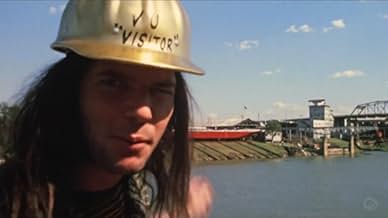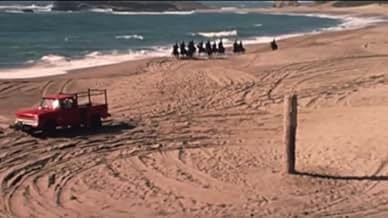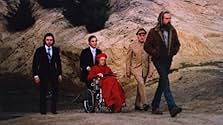Don't look for a narrative, it's an Art Film. A series of vignettes referencing the South and a commentary on religion as opiate. See it for the live footage of Buffalo Springfield and CSNY.Don't look for a narrative, it's an Art Film. A series of vignettes referencing the South and a commentary on religion as opiate. See it for the live footage of Buffalo Springfield and CSNY.Don't look for a narrative, it's an Art Film. A series of vignettes referencing the South and a commentary on religion as opiate. See it for the live footage of Buffalo Springfield and CSNY.
Storyline
Did you know
- ConnectionsFeatures The Hollywood Palace (1964)
- SoundtracksFor What It's Worth
Written by Stephen Stills
Performed by Buffalo Springfield (as The Buffalo Springfield)
Featured review
Having been a fan of Neil Young for several years, I never thought I'd get the opportunity to see this rare film. However - a bit of online sifting is all it takes nowadays, and Journey Through The Past is out there as a BitTorrent. Not sure if this is something IMDb condone, but I'm sure they'll let me know by deciding whether to post that or not! The copy I've found is clearly from an n-th generation videotape (how it found its way on to any videotape I'm sure is a story in itself, as the film never found commercial release outside of the few cinemas that showed it) and the picture is washed-out, occasionally wobbly but essentially watchable. Basically no worse than finding a vintage first-issue Chainsaw Massacre tape, or any video nasty of a similar age.
The film itself has had a reputation over the years for being poorly conceived and poorly received; an incoherent navel-gazing exercise that probably didn't even make much sense to Young once the pot wore off. What must be considered, though, is that much the same was said of Young's '73-'75 album releases in their day, and much of his music from that "Dark Period" is now held to be among his strongest work. Hence my summary headline above; if you appreciate the myriad tangents that Young went off on during his 1970s recorded work, then you'll at least know where this film's coming from.
In more detail then, Journey Through The Past is part-documentary of Young's first five-six years as a recording, touring artist; and smaller parts road movie and surrealist fantasy. If you consider these three aspects together, you might get a sense of why this film reminds me on more than one occasion of Werner Herzog's late 60s-early 70s work, particularly Fata Morgana (there's even some brief desert scenes here among the fantasy sequences). That is, of course, if Herzog suffered a serious whack on the head and lost all of his directorial and editorial talent in a month-long amnesia; Young was no great movie-maker at this early stage in his career (and judging by Human Highway a decade later, probably wouldn't learn much more).
But therein lies a lot of the film's charm; when you hold this up against, say, Led Zeppelin's rather pompous Song Remains The Same, Journey Through The Past does have a lot going for it in its homespun unpretentiousness and intimacy. The countercultural-political sequence of the film, about 45 minutes in, might be clumsily handled, but you kind of get the idea. There's a fair amount of goofy comedic material here too, from a grinning Buffalo Springfield camping it up in a TV spot, to Graham Nash in a dapper gold waistcoat calling for the legalisation of marijuana (after identifying a drummer-rolled joint at first sight), to a hard-hatted Young clambering around in a scrapyard then later giving some Jesus Freaks a pricelessly deadpan baiting.
And of course, if you want some electrifying footage of early CSN&Y, it's here providing arguably the highlight of the movie; you'll wish this footage went on for much longer. Much proof is provided that Stephen Stills was possibly the coolest human being in the universe during the early 70s. The 'Harvest' rehearsals do drag on a bit (thankfully not to the sheer tedium that they went to on the soundtrack album) but are still an interesting snapshot of Young's work-in-progress at the time. And if you're left bemused by the bearded wanderer/junkie, black hooded Klansmen, and the bishop, the general and their chauffeur in the fantasy sequences, I wouldn't take it too seriously. Young did pass it off as "No plot. No stars". Enjoy this film primarily as a great rock documentary. Seek it out!
The film itself has had a reputation over the years for being poorly conceived and poorly received; an incoherent navel-gazing exercise that probably didn't even make much sense to Young once the pot wore off. What must be considered, though, is that much the same was said of Young's '73-'75 album releases in their day, and much of his music from that "Dark Period" is now held to be among his strongest work. Hence my summary headline above; if you appreciate the myriad tangents that Young went off on during his 1970s recorded work, then you'll at least know where this film's coming from.
In more detail then, Journey Through The Past is part-documentary of Young's first five-six years as a recording, touring artist; and smaller parts road movie and surrealist fantasy. If you consider these three aspects together, you might get a sense of why this film reminds me on more than one occasion of Werner Herzog's late 60s-early 70s work, particularly Fata Morgana (there's even some brief desert scenes here among the fantasy sequences). That is, of course, if Herzog suffered a serious whack on the head and lost all of his directorial and editorial talent in a month-long amnesia; Young was no great movie-maker at this early stage in his career (and judging by Human Highway a decade later, probably wouldn't learn much more).
But therein lies a lot of the film's charm; when you hold this up against, say, Led Zeppelin's rather pompous Song Remains The Same, Journey Through The Past does have a lot going for it in its homespun unpretentiousness and intimacy. The countercultural-political sequence of the film, about 45 minutes in, might be clumsily handled, but you kind of get the idea. There's a fair amount of goofy comedic material here too, from a grinning Buffalo Springfield camping it up in a TV spot, to Graham Nash in a dapper gold waistcoat calling for the legalisation of marijuana (after identifying a drummer-rolled joint at first sight), to a hard-hatted Young clambering around in a scrapyard then later giving some Jesus Freaks a pricelessly deadpan baiting.
And of course, if you want some electrifying footage of early CSN&Y, it's here providing arguably the highlight of the movie; you'll wish this footage went on for much longer. Much proof is provided that Stephen Stills was possibly the coolest human being in the universe during the early 70s. The 'Harvest' rehearsals do drag on a bit (thankfully not to the sheer tedium that they went to on the soundtrack album) but are still an interesting snapshot of Young's work-in-progress at the time. And if you're left bemused by the bearded wanderer/junkie, black hooded Klansmen, and the bishop, the general and their chauffeur in the fantasy sequences, I wouldn't take it too seriously. Young did pass it off as "No plot. No stars". Enjoy this film primarily as a great rock documentary. Seek it out!
- burns_alan29
- Jul 6, 2008
- Permalink
Details
- Release date
- Country of origin
- Language
- Also known as
- ジャーニー・スルー・ザ・パスト
- See more company credits at IMDbPro
Contribute to this page
Suggest an edit or add missing content

Top Gap
By what name was Journey Through the Past (1973) officially released in Canada in English?
Answer













